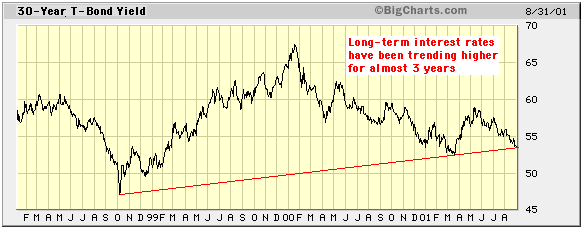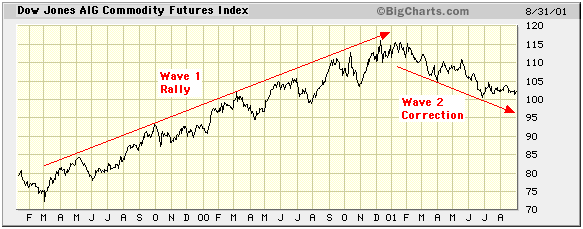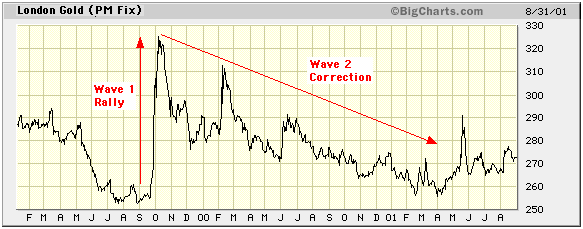
The Trend
Towards Higher Inflation
Inflation - a political
imperative in the US
By allowing debts to be repaid in depreciated
currency, inflation favours debtors at the expense of creditors. Also,
inflation often has the effect of boosting asset prices, thus increasing
the collateral that supports existing debts and providing the basis for
new debts. A problem inevitably arises, however, because creditors aren't
stupid - they don't like to see their real returns dwindle as a result
of loans being repaid with depreciated money. They therefore begin to adjust
interest rates higher to account for the currency's anticipated loss of
purchasing power over the period of the loan.
The US has experienced a high inflation
rate over the past few years. However, as discussed many times in the past,
the strong Dollar has suppressed the negative effects of the inflation.
By helping to keep producer and consumer prices in check, the rising trend
in the Dollar's foreign exchange value has alleviated the need for the
high market interest rates that would normally result from high inflation.
With the Dollar's foreign exchange value no longer trending skyward, a
substantial rise in long-term market interest rates is now on the cards.
American voters are up to their eyeballs
in debt, so higher market interest rates and the knock-on effects of higher
interest rates (less spending, less investment, lower growth, higher unemployment)
would cause big problems to say the least. The potential solutions? Allow
the economy to experience a severe multi-year recession to wash away the
excesses, thus guaranteeing a loss for the incumbents at the next election,
or inflate at an even faster pace to postpone the day of reckoning (hopefully,
to some time after the next election). Clearly, the political pressure
on the Fed to keep inflating will be enormous.
The big question is, if deflationary
forces take hold can the Fed keep the money supply expanding? The answer
is no, not if it sticks to its routine of simply setting a target Fed Funds
Rate. As the Japanese have shown, even taking interest rates all the way
down to zero is of no benefit if lenders stop lending and borrowers stop
borrowing. However, the Fed's power is not limited to the setting
of a Fed Funds Rate target. In fact, as the following passage from Bob
Woodward's book "Maestro" clearly shows (the passage deals with the tactics
contemplated by the Fed in the wake of the 1987 stock market crash), the
Fed's power to create money out of nothing is effectively unlimited:
"They [the Fed] had the legal
power to buy up the entire national and private debt, theoretically infusing
the system with billions, even trillions, of dollars, more than would ever
be necessary to restore liquidity and credit. Of course, the result of
that would be Latin American-style inflation.
In addition, there was an ambiguous
provision in Section 13 of the Federal Reserve Act, the lawyers told Greenspan,
that could allow the Fed, with the agreement of five out of seven members
of its board, to loan to institutions - brokerage houses and the like -
other than banks. Greenspan was prepared to go further over the line. The
Fed might loan money, but only if those institutions agreed to do what
the Fed wanted them to do. He was prepared to make deals. It wasn't legal,
but he was willing to do it, if necessary. There was that much at stake.
At that moment, his job was to do almost anything to keep the system righted,
even the previously inconceivable."
If at some future time the Fed does
make full use of the money-creating powers available to it then the power
of the Dollar (purchasing power, that is) will plummet. However, a reduction
in the Dollar's purchasing power will always be tomorrow's problem until
it gets completely out of control, at which point it will become today's
problem. Until the depreciating Dollar does become today's problem, that
is, until soaring interest rates make it today's problem, there is no reason
to expect the US monetary authorities to do anything other than inflate.
Anticipating tomorrow's
headlines
It is easy to get caught up in the
news of the day when all we read/hear is that commodity prices are tumbling,
inflation is nowhere to be seen and central banks must keep cutting interest
rates to avoid deflation. However, when we step back and take a broad view
of the financial markets and of the leading indicators that give us clues
as to what tomorrow's headlines are going to be, a different picture
emerges.
What we see is that long-term interest
rates bottomed in October of 1998 and made a higher low in March of 2001.

We see that commodity prices bottomed
during the first half of 1999 and appear to be in the process of completing
a normal (Wave 2) correction.

We see that the gold price bottomed
in August of 1999 and completed a normal (Wave 2) correction earlier this
year.

In general terms, the financial markets
are whispering the message that we are in the very early stages of an inflationary
cycle. That message is, at the moment, barely audible over the deflationary
noise, but it will get louder over the next 12 months.
Of course, what we are going to see
over the next 12 months as commodity prices complete their corrective moves
and turn higher is not inflation, but the effects of the inflation
(the increase in the money supply) that has already occurred. Over the
past few years the effects of the rampant inflation that has been going
on in the US have been muffled by the upward trend in the Dollar's foreign
exchange value, but that protective shield is in the process of disappearing.
Regular financial market forecasts
and
analyses are provided at our web site:
http://www.speculative-investor.com/new/index.html
One-month free trial available.

|

